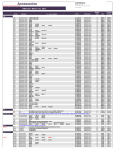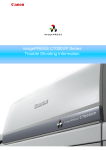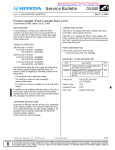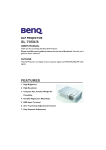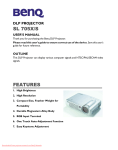Download Life is good RD-JT21 Projector User Manual
Transcript
RD-JT20 / RD-JT21 SERVICE MANUAL C a u tio n B e s ure to read this m a nu al b efo re se rvic in g. T o a s sure s afe ty from fire, e lec tric s h oc k , in jury, ha rm fu l ra dia tio n an d m a terials, vario us m eas u re s are pro vid ed in this A c er D LP p roje ctor. B e su re to read c aution ary item s de sc ribed in th e m a nu al to m ain tain s afe ty be fore se rvicing. S e rvic e W a rn in g 1 . W he n re plac e th e la m p, to avo id bu rns to yo r fing ers . T he la m p b eco m es too h o t. 2 . N e vr to uc h the la m p b ulb w ith a fing e r or an ything els e . N ev er drop it o r giv e it a s ho ck . T h ey m a y c aus e bu rs ting of the bu lb . 3 . T h is pro jec to r is pro vided with a high volta g e circ uit fo r the lam p . D o n o t to u ch th e elec tric pa rts o f po w rer u nit (m a in ), w h en tu rn on th e p ojec to r. 4 . D o n ot tou ch th e ex h au st fa n, du rin g o peratio n. C o n te n ts 1 . S pe c ific a tion s...........................................................................................................................................2 2 . P ac k ag in g D e sc rip tio n.............................................................................................................................4 3 . R e m ote C o ntro l........................................................................................................................................6 4 . Ins talltin ....................................................................................................................................................7 5 . P rod uc t D es crip tio n ..................................................................................................................................8 6 . C ircu it O p era tion T he ory........................................................................................................................21 7 . LE D Lo c ation L ist...................................................................................................................................27 8 . T ro u ble Sh oo tin g....................................................................................................................................28 9 . R e plac em e nt P arts .................................................................................................................................31 1 0. M aintan c e.............................................................................................................................................39 1 1. P a rts Lis t...............................................................................................................................................42 1 2. S c h em a tics ...........................................................................................................................................44 A pp en dix A U sing th e F a ctory As sis t T o ol..................................................................................................65 A pp en dix B F irm w are D ow n-L oa d P roe d ure ..............................................................................................72 A pp en dix C C on trol P ro jec tor by u s ing a pe rs on al.....................................................................................76 A pp en dix D D M D C hip ................................................................................................................................8 0 A pp en dix E As sis ta nc e T o o l C ha rt.............................................................................................................82 A pp en dix F F ac to ry D e fa ult V alu e..............................................................................................................83 1 SPECIFICATIONS AND PARTS ARE SUBJECT TO CHANGE FOR IMPROVEMENT. 1. Specifications A. Projector Specifications Technical Specifications Note: All specifications are subject to change without notice. General Product name: Personal Projector Model name: RD-JT20 (X-XGA) 1024X768 dpi XGA RD-JT21 (S-SVGA) 800X600 dip SVGA ________________________________________________________________________ Optical Display system 1-CHIP DMD Lens F/Number F/2.6 Focal Length: F = 36 mm Lamp 120W VIP lamp ________________________________________________________________________ Electrical Power supply AC100 ~ 240V, 2.3A, 50/60 Hz (Automatic) Power consumption 185 W (Max) ________________________________________________________________________ Mechanical Dimensions 220 mm (W) x 52 mm (H) x 175 mm (D) Operating temperature range 10¡ ~ 40 ¡ Weight 3.85 lbs (1.69kg) ________________________________________________________________________ Input terminal Computer Input RGB input D-sub 15-pin (female) Video Signal Input S VIDEO Mini DIM 4-pin terminal VIDEO RCA Jack terminal Audio Signal Input Mini Jack Mono Audio Terminal ________________________________________________________________________ Output 1 Watt speaker x 1 2 B. Timing Chart Resolution 640x350 640x400 720x400 720x400 640x480 640x480 640x480 640x480 800x600 800x600 800x600 800x600 800x600 832x624 1024x768 1024x768 1024x768 1024x768 1280x1024 H Sync (kHz) 31.5 37.9 31.5 37.9 31.5 37.9 35.0 43.3 35.2 37.9 46.9 48.1 53.7 49.7 48.4 56.5 60.0 68.7 64.0 V Sync (Hz) 70.1 85.1 70.0 85.1 60.0 72.8 66.7 85.0 56.3 60.3 75.0 72.2 85.1 74.5 60.0 70.1 75.0 85.0 60.0 Remark VESA VESA VESA VESA Macintosh VESA VESA VESA VESA VESA VESA Macintosh VESA VESA VESA VESA VESA 3 2. Packaging Description 2.1 Projector Packaging 4 2.2 Dimensions 2.3 Shipping Contents The LG RD-JT20/RD-JT21 Series Projector is shipped with the necessary cables required for standard PC, Macintosh or laptop computer connections. Carefully unpack and verify that you have all the items shown below. missing, please contact your place of purchase. If any of these items are 5 3. Remote Control Description Remote Control Features The remote control sensors are located in the front/back of the projector. The distance between the sensor and the remote control should not exceed 6 meters. 6 4. Installation 4.1 Screen Size Place the projector at the required distance from the screen according to the desired picture size (see the table below). 4.2 Connecting to Various Equipment It only takes a few seconds to connect your RD-JT20/RD-JT21 Series projector to your computer/notebook, VCR or other systems. However, a Mac adapter (an optional accessory) is needed for connection for Macintosh users. 7 5. Projector Description 5.1 Product Description 5.1.1 Projector 1. 2. 3. 4. 5. 6. 7. 8. External control pane Projection lens Front adjustment feet IR remote sensor Ventilation grill Kensington lock AC power cord input S-video connector 9. RCA connector 10. D-sub connector (for computer/HDTV input) 11. Audio input 12. Rear adjustment feet 13. Lamp access door (underneath unit) 8 5.1.2 External Control Panel The Infrared Remote Receiver (Front and Rear) allows the projector to accept signals from the remote control. For best results, be sure to aim the control toward the sensor without any obstructions between the two, and at a distance no greater than 6 meters. Menu will display the menu system on screen. Press Menu again to access the sub-menus. Left and Right help you navigate among choices and settings in the menus and sub-menus. However, when the onscreen menu is not activated, the Left and Right buttons will function as Keystone +/- hot keys. Press the Exit button to go back to the main menu. menu system. Press Exit again to leave the The Status Indicator will blink or light up when the lamp needs service, cooling or replacement. When the projector is on, Back-lit Power will blink during warm-up and turn to solid green to indicate the projector is ready for use. Press Power for 1 second to turn the projector on or press power key twice to turn off the projector. Auto key: Automatically sense the best picture quality for current received signals. Source key: Select signal sources, PC, YPbPr, Video, S-Video. 9 5.1.3 Adjuster There is one adjuster at the bottom of the projector. It raises up the projector when the projected image is offset vertically. 1. Lift the projector up and press the adjuster button to release the adjuster. 2. The adjuster will drop into position and be locked. 3. Remember to press the adjuster button and push the adjuster back to as it was. 5.1.4 Projector Features The RD-JT20/RD-JT21 Series Projector integrates high performance optical engine projection and user-friendly design to deliver high reliability and better experience. The RD-JT20/RD-JT21 Series Projector offers the following features: One key auto-adjustment to display the best picture quality Easy digital keystone correction through hot keys to correct tilted pictures Powerful AV function to provide high AV picture results. Compact and portable unit Full-function remote control Easy to set up and use One screen menus in 7 languages: English, French, German, Italian, Spanish, Portuguese, and Traditional Chinese. Adjustable color balance control for data/video Ultra-high brightness projection lamp Ability to display high quality 16.7 million colors Powerful AV function to provide high AV picture results. HDTV compatibility (YPbPr) Note: The brightness of your machine will vary depending on the ambient room conditions and contrast/brightness settings. 10 5.2 Product Appearance 11 5.3 Local keyboad & function Description Power Key Type: Push button, no repeat Description: When the projector is in power-off status, press this key for more than 1 second to power on the projector. Under normal operation condition, press this key for more than 1 second enter power off layer, then press this key again to turn down the power (besides CPUs) and standby the projector. ---------------------------------------------------------------------------------------------------------------------- Menu Key Type: Push button, no repeat Description: There are two conditions to press this button, 1). The OSD menu is not popped up. To press this button will pop up the OSD menu and start the OSD user control function. 2). The OSD menu has already been popped up. To press this button will enter into the functional item level under the page icon group, as user push the button again, that will activate the selected item. 12 ---------------------------------------------------------------------------------------------------------------------Exit Key Type: Push button, no repeat Description: There are three conditions to press this button: 1). The OSD menu is not popped up. To press this key is not functional. 2). The OSD menu is in the page icon group, press this key then the OSD menu will be closed. 3). The OSD menu is in the functional item level, press this key then the OSD menu will be back to the page icon group & save the functions value to EEPROM. ---------------------------------------------------------------------------------------------------------------------+/ Key Type: Push button, repeat Description: There are two conditions to press this button: 1). The OSD menu is not popped up. This is the hot key of Keystone function. 2). The OSD menu has already been popped up: If the page icon group is activated, press the Key will select rightly to another page icon. If the activating page icon is the most right icon, push the button will select to the most left control icon. If the gauge type item is activated, push the key will increase the value of the gauge, if the value reach to its maximum, To press this button continuously will not have any response. If the set value/ key will execute type item, the key type is no repeat, push the toggle the right sub-item function. ----------------------------------------------------------------------------------------------------------------------/ Key Type: Push button, no repeat Description: 1). The OSD menu is not popped up. This is the hot key of Keystone function.. 2). The OSD menu has already been popped up: If the page icon group is activated, press the Key will select left to another page icon. If the activating page icon is the most left icon, push the button will select to the most right control icon. If the gauge type item is activated, the key type is repeat, push the key will decrease the value of the gauge, if the value reach to its minimum, to press this button continuously will not have any response. If the set value/execute type item, the key type is no repeat, push the key will toggle the left sub-item function. ---------------------------------------------------------------------------------------------------------------------13 Auto Key Type: Push button, no repeat Description: Execute Auto function to make the graphic mode to re-adjust H-Size, H-Phase, H-Position and V-Position immediately and the video mode to re-detect the system standard. ---------------------------------------------------------------------------------------------------------------------Source Key (Computer, YPbPr, Video, S-Video) Type: Push button, no repeat Description: Press Source key to display the current source information, press again to Force net Source, Source cycle are PC, YPbPr, Video, S-Video. ---------------------------------------------------------------------------------------------------------------------Active page icon Page icon Page icon group Gauge type item Active Item Brightness Projection Set value type item Gauge Normal Ceiling Rear Sub-item Reset Functional item level Execute type item Active sub-item 5.4 TV Video Input 1. S-Video 2. RCA 14 5.5 VGA Video Input 15pin mini D-sub connector is on the captive signal cable for IBM VGA, 8514A or compatible graphics adapters. The pin assignments of this connector are as the following: 5 1 6 10 11 15 **15 pin definition of the mini D-sub male for DDC1/2B protocol 1. Red video (HDTV-Pr) 2. Green Video (HDTV-Y) 3. Blue Video (HDTV-Pb) 4. Monitor ID bit 2 5. Return 6. Red Video Return 7. Green Video Return 8. Blue Video Return 9. +5 Volt Supply (Mandatory Supply) 10. Sync. Return 11. Monitor ID bit 0 12. Bi-directional data (SDA) 13. Horizontal Sync 14. Vertical Sync 15. Data clock (SCL) 15 5.6 External Power status indicator 5.6.1 Standby/On LED indicator Power LED indicator: (Blue/Orange) 1. 2. 3. 4. Operation Status Standby Heating process after powered on Power on and stable status Powered off and during cooling process Power Indicator Solid green Blinking green Solid green Blinking green Power off : Press Power button for 1 second to turn off the lamp. The LED will then blink green and the lamp shuts down, but the fan will still work for 1 minute to cool down the lamp. Meanwhile, its prohibited to turn on the unit during the 1-minute cooling procedure. After that 1-minute cooling down procedure, the LED will light solid green and the fan stops. (Note: Lamp Protection Procedure: If user tries to turn on the lamp again during the cool down procedure, the projector will ignore the command until cool down procedure is finished). 2. When user presses Power button, following message will be displayed to make sure user really want to power off the unit: Are you sure to power off? Press power again to power off. 1. 5.6.2 Lamp/temperature status LED indicator 1. Lamp Exceed service hours: When this LED lights Orange continuously, the lamp usage has exceeded (*1500) service hours. After this symptom appears, it is advisable to replace the projection lamp as soon as possible. CHANGE THE LAMP AND RESET THE LAMP TIMER. message will be displayed on the screen if the lamp has operated for (*1400) hours. See figure 1 YOU HAVE TO CHANGE THE LAMP message will be displayed on the screen if the lamp has operated for (*1479) hours. CHANGE THE LAMP message will blink on the screen together with the sold Orange LED if the lamp has operated for more than (*1500) hours. See figure 3. The warning message will be displayed when the projector is turned on (last for 30 seconds), 5 minute after turning on (last for 30 seconds) and 10 minutes after turning on (last for 30 seconds). After 10 minutes after turning on, the projector will shut down and following message will be shown: Out of lamp usage time 16 Power off to protect projector The message will last for 5 seconds before going off. Lamp replacing warning message Figure 1 Figure 2 Figure 3 Lamp is not well attached: If the LED blinks, it indicated that the lamp is not attached properly. 2. Temperature is too high: If the projectors internal temperature is too hot to operate safely, the LED will blink for one minute and then the lamp will go off automatically. 3. Normal status: If the LED light is off, it means the lamp and temperature inside the projector is under normal situation. 5.7 Power Supply requirement 5.7.1 Input Power Requirement Input Voltage Range The unit shall meet all the operating requirements with the range 100-240 VAC Frequency Range The unit shall meet all the operating requirements with an input frequency range 50 Hz ~ 60 Hz Power Consumption Typical power consumption 170 W Inrush Current Power supply inrush current shall be less than the ratings of its critical components (including power switch¡fuse¡rectifier¡and surge limiting device) for all conditions of line voltage. Regulation Efficiency 80 % (typical) measuring at 115Vac and full load 17 5.7.2 Output Power Requirement The power supply can provide DC output as below¡ NO. Voltage Regulation Load Current Range Ripple & Noise 1 +5 V +-5% 0.5 A ~ 1.0 A 100 mV 2 +5 V +-5% 0.05 A ~ 0.15 A 50 mV 3 +12 V +-5% 0.2 A ~ 0.6 A 150 mV 4 +12 V +-5% 0.3 A ~ 0.5 A 200 mV 5 +3.3 V +-5% 0.5 A ~ 1.5 A 50 mV 5.7.3 Lamp Power specifications Applicable Lamp 120W Short-Arc VIP R 120/P16 Lamp, AC operation Lamp Voltage 78 (+22/-13)V (Initial dispersion condition of Lamp) Starting pulse from Igniter Pulse voltage 5.7.4 Power Standby mode Set power standby mode total power consumption < 15 W 5.7.5 Power good signal Active high after 5 Volt reach 95% of its rating and goes to logic low at least 0.5ms before power falls to 90% of its rating. This Power Good Signal is not provide by the Osram PWR. 18 5.8 Characteristics of input/outputs Signal LINE, NEUTRAL RDATA GDATA BDATA GDATA_SOG HDATA VDATA SDATATA SCLDATA RXD TXD Parameter Main voltage Min 88 Typical Input power Standby power Impedance 255 Amplitude Black pedestal Bandwidth Transfer char. (gamma) Cross-talk RDATA, GDATA, BDATA Impedance Amplitude Video amplitude Sync amplitude Black pedestal Bandwidth Transfer char. (gamma) Cross-talk RDATA, GDATA, BDATA Impedance Amplitude, low level Amplitude, high level Frequency Impedance Amplitude, low level Amplitude, high level Frequency Impedance Amplitude, low level Amplitude, high level Wave forms, timing Impedance Amplitude, low level Amplitude, high level Wave forms, timing Impedance Amplitude Wave forms, timing 0.7 0 140 TBD Impedance Amplitude Wave forms, timing 75 75 1 0.7 0.3 0 140 TBD 0 2.5 24 0 2.5 48 0 2.5 0 2.5 -25 -25 1 1 TBD TBD TBD TBD Max 264 7 Volt rms Watt Watt Ohm Volts peak-to-peak Volts M Hz -45 DB Ohm Volts peak-to-peak Volts peak-to-peak Volts peak-to-peak Volts M Hz -45 0.8 5 100 0.8 5 120 DB K ohm Volt Volt K Hz K ohm Volt Volt Hz 0.8 5 Volt Volt According to I2C spec. 0.8 5 Volt Volt According to I2C spec. 25 Volt According to RS232 spec. 25 Volt According to RS232 spec. 19 5.9 Timing The PC signal timing is as following: 640x400 at 70Hz 640x480 at 60Hz 640x480 at 72Hz 640x480 at 85Hz 800x600 at 60Hz 800x600 at 72Hz 800x600 at 75Hz Standard Type DOS Industry VESA VESA VESA VESA VESA Resolution H*V 640x400 640x480 640x480 640x480 800x600 800x600 800x600 -/+ -/- -/- -/- +/+ +/+ +/+ H Frequency (KHz) 31.47 31.469 37.861 43.269 37.879 48.077 46.875 V Frequency (Hz) 70.08 59.94 72.809 85.008 60.317 72.188 75 Pixel Clock (MHz) 28.32 25.175 31.5 36 40 50 49.5 Standard Polarity H/V Standard Type VESA 1024x768 832x624 1024x768 1024x768 1024x768 1024x768 at 43.5Hz at 74Hz at 60 Hz at 70Hz at 75Hz at 85Hz (Interlace) Macintosh VESA VESA VESA VESA VESA Resolution H*V 800x600 832x624 1024x768 1024x768 1024x768 1024x768 1024x768 Standard Polarity H/V 800x600 at 85Hz +/+ -/- +/+ -/- -/- +/+ +/+ H Frequency (KHz) 53.67 49.72 35.5 48.4 56.476 60.023 68.677 V Frequency (Hz) 85.06 74.55 43.5 60.0 70.069 75.029 84.997 Pixel Clock (MHz) 56.25 57.29 44.9 65 75 78.75 94.5 20 6. Circuit Operation Theory Black Diagram A. Main Board Below is the simple block diagram of Main Board. D_SUB I2C Analg Flat Panel Interface AD9883 I2C EEPROM RGB888 signals Address Control Signals Image Processor PW166 Flash Data I2C S-Video RCA Video Decoder SAA7114 YUV 422 Control Signals Clock GEN Clock signal RGB 888 Signals I2C Control Signals DMD Driver Board As the diagram shown above, here is the function of every discrete block. D_SUB input Analog RGB data input, the standard maximum analog input resolution is SXGA. There also some interface signals from the VGA cable, they are: ADHSYNC Providing the Horizontal Synchronization signal to AD9883. ADVSYNC Providing the Vertical Synchronization signal to AD9883 DDC interface Providing Digital Display Channel, which include VCC (Pin9), SCL (Pin15), SDA (Pin12). Analog Flat Panel Interface (ADC Converter), AD9883 The ADC converter digitizes the input analog RGB data signal from D_SUB and output the digital data streams to Image Processor. 21 The normal voltage level of analog RGB input signals is about 0.7V, while the ADC digital signal output to Image Processor is LVTTL level, about 3.3V. The ADC, AD9883 could supports up to pixel rate at about 140MHZ, which is about SXGA 75HZ analog input signal. There are some other interface signals related to AD9883 SOGIN Sync On Green input from Image Processor, the signal enable the RD-JT20/RD-JT21 support the very special VGA input signal. GCOAST Input signal from Image Processor, the signal enable the RD-JT20/RD-JT21 support the Macintosh analog input format. GCLK Output to Image Processor as Pixel Clock, providing the reference clock for Image Processor. GHS Providing the Horizontal Synchronization signal to Image Processor. GVS Providing the Vertical Synchronization signal to Image Processor. GRE,GGE,GBE Digital data stream to Image Processor which is higher than SXGA 75Hz. Image Processor (PW166) The most important IC is the image Processor, here below list its main function - Supporting input digital data stream up to UVGA and output digital data up to SXGA - Two input port, which are Graphic port (VGA format) and Video port (video decoder format). - Frame rate conversion, the output frame rate is independent from the input frame rate and the most important feature of the Image Processor is memory inside, there is no need of external memory for frame rate conversion. - Up and Down scaling of different input resolution, ensure the same output image size. - Providing Bitmap OSD picture, which if more fancy than normal OSD chip. - On chip Microprocessor. The Image Processor is a highly integrated circuit, it include MCU, Scalar, OSD. This will increase the stability of the system. There is some control signals list below: DCLK pixel clock output to DMD driver BD, provided as a reference clock for DMD driver. DVS Vertical synchronization signal output to DMD BD, provided as Vertical reference signal for DMD driver. DHS Horizontal synchronization signal output to DMD BD, provided as Horizontal reference signal for DMD driver. DEN Data enable signal output to DMD BD, provided as a valid data indicator signal for DMD driver. VCLK V-port pixel clock. VPEN V-port data enable. 22 VVS V-port Vertical Synchronization. VHS V-port Horizontal Synchronization. VFILED V-port Even/Odd frame indicator. RESETZ Output to DMD driver BD as RESETZ signal for DMD normal operation. ABNORMAL Input to CPU for indicating abnormal condition, if the CPU detects an abnormal status, it will disable lamp ignition. POWERON Output to power to enable the other power source into normal working situation. LAMPLIT Input signal as an indicator that the Lamp is ON or OFF. LED1, LED2 Output to TR BD to enable the LED ON or OFF. IRRCVR0 System IR input to CPU as remote control signals. MCKEXT Memory clock to CPU. DCKEXT Data clock to for Scaling. I2C_SDA, I2C_SCL I2C format data transfer line. EEPROM Store the system information for user friendly. Flash Memory System software was stored in this chip; the memory size is 4M bits. IR Receiver schematic: The IS1U621 is miniaturized receivers for infrared remote control systems. PIN diode and pre-amplifier are assembled on lead frame, the epoxy package is designed as IR filter. The demodulated output signal can directly be decoded by a microprocessor. The main benefit is the reliable function even in disturbed ambient and the protection against uncontrolled output pulses. Electronic System Protection for abnormal state: The circuit of electronic system protection for abnormal state is used for the hardware light off and power off in abnormal state of thermal and safety issues. If the protection function is active then the software system will detect the abnormal signal. Sensor BD: The Sensor BD provides the color wheel index signal to DMD BD. The CWINDEX shall indicate the beginning of the red light on the DMD device. The phase of the display data on the DMD based on the CWINDEX signal. It can be configured to delay the CWINDEX for electronic alignment of the color wheel. The timing of CWINDEX and the delayed CWINDEX is shown in Figure 1. 23 CWINDEX DELAYED CWINDEX DMD COLOR Red FIGURE 1 B. Power Supply Module Power Supply Module provide 12V, 5V, 3,3V for all system. And power supply module also include PFC board and DC/DC portion. ïîÊ Ô¿³° Ú¿²ï ÐÚÝ Ô¿³° б©»® ×ÙÒ×ÌÑÎ ßÝ ×Ò ÐÑÉÛÎ ÍËÐÐÔÇ Ó±¼«´» Ô¿³° Ú¿² б©»® Ú¿² ÜÝ ¬± ÜÝ ÛÓ× Ú·´¬»® ïîÊôëÊôíòí Ú±® ͧ-¬»³ Pixelworks scaler(PW166) with x86 CPU and OSD and SDRAM is used for system control. It control hole system operation and with crucial role of this system. (Include fan speed, inter-lock SW, .) 24 C. A/D-DECODER (AD9883) A/D-decoder (AD9883) is used for decode VGA analog signal to digital signal (RGB 888) which provide 24 bit true color resolution. Also can accept SOG(sync on green) and composit signal for PC input. It also support YPbPr signal. From Power Supply Regulator(3.3v) 12V,5V,3.3 EEPROM (16K bit) ThERMAL SENSOR Scaler (memory +cpu+osd) D-Sub Input RGB888 Signal To DMD Driver Board Power(12V,5V,3.3V) To DMD Driver Board Control Signal To DMD Driver Board AD Converter S-Video& RCA input Audio Input Video Decoder Speaker Audio Amplifier D. DMD Driver DMD driver board that transfer PW166 scalar output RGB888 signal to DMD chip acceptable signal to driving DMD mirror operation. The relate diagram as below: Ñ°¬·½¿´ Ü»ª·½» Ô¿³° Ó±«¼´» ÑÐÌ×ÝßÔ ÛÒÙ×ÒÛ Ð¸±¬± Í»²-±® ÝÑÔÑÎ ÉØÛÛÔ -·¹²¿´ ÎÙÞ ÜÓÜ ÎÙÞèèè Í·¹²¿´ б©»®øïîÊôëÊôíòíÊ÷ ÜÓÜ ÜÎ×ÊÛÎ ïîÊ Ý±²¬®±´ Í·¹²¿´ 25 E. Hole system block diagram is show as below Lamp Module Optical Device PFC Optical Engine DMD Lamp On EMI Filter Power Board and Ballast Color Wheel DC/DC 3.3V, 5V, 12V Ballast Color Wheel Signal DMD Board DMD FPC Color Wheel Sensor Main Board Color Wheel Sensor Board Speaker PW166 Scaler Keypad IR Rear Board Control Signal Sensor Signal RGB 888 Power 5V, 3.3V, 12V Power & Control Data IR Front Board 12V/5V Fan A/D Converter Video Decoder Audio Amplifier D-Sub Input Video Input S-video Input Audio Input 26 7. LED Indication List LED Indication Symptom Failure Check Point Status LED Solid Green Lamp Hour Over 1400 Hr. Status LED Flash Green 1. Fan Spin DMD Board Plug Power core to see fan spin or not 2. Door Lock Main Board Force to contact 1. Change the the doorlock to see Doorlock switch it works ok or not 3. Color wheel DMD Board To turn on the projector to hear the color wheel is running or not PCB 5. Thermal Power LED Solid Orign Standby Power Power LED Flash Green Power LED Solid Green Power on Sequence Normal Operation Power LED Flash Orgin Reference See details in User's Manual 4. Lamp Main Board Action Waiting the system already cool down, and the above 3 items is OK, but the Lamp is not striked on After few minutes operation, the system is automatically power down. 1. Change New Lamp 2. Reset the Lamp Hour 1. Change the Fan 1. Follow the Power can not be truned on Trouble shoutng guide 1. Change the Lamp 2. If still not works, change the ballast 1. Thermal Problem Power off Sequence 27 8. Trouble Shooting 8.1 No Power Power can not be truned on Loop 2 1. Status green blink (Loop1) 2. Status orange blink (Look 2) 3. No LED (Loop 3) Change Main Board Loop 1 Check lamp door if its well closed Loop 3 No Close the lamp door securely No Exchange the micro switch & thermal sendor couple No Change the 12V fan Yes Change Assy PWR module Check Main Bd J7 pin 1 to GND or not? Yes Check 12V fan if it's spin Yes Reconnect the color wheel cable Change main board No No Check the color wheel cable if the cable loose No Is color wheel spin Yes Yes Check main board at J1 on pin 26, 27 if voltage high or not? Check ballast if there is sound like ignite the lamp Yes Yes Change color wheel Check Assy PWR module at J104 on 1.Pin(3, 12)if output 5V 2. Pin(6, 7) if output 12V 3. Pin (2, 13) if output 3.3V No Change the lamp No Change Assy PWR module Yes Change the ballast 28 8.2 No Signal Displayed No PC signal Yes Check main board at RP5~6 (Net DRE), RP3~4 (Net DGE), RP1~2 (Net DBE) if output or not No Change DMD board Yes change main board 8.3 No Sound Output No Sond Output Check speaker device is it work normal No Change Speaker Yes Change Speaker Yes Check Main BD J6 if there is output or not? No Change Main Board 29 8.4 LED Normal but No Image Displayed LED on standard, but no picture displayed Is the picture full black Yes Check main BD at RP5~RP6 (Net DRE), RP3~RP4 (Net DGE), RP1~RP2(Net DBE) if output or not No No Change color wheel sensor baord No Check DMD board J3 on pin 10 if output 120HZ or not? Yes Change DMD board change main board Yes Change DMD Board 30 9. Replacement Parts 31 32 33 34 35 36 37 38 10. Maintenance 10.1 Lamp Information Use and Replacement of Lamp The projector lamp lifetime normally is approximately 1200 to 1500 hours. the normal lamp life, pictures and colors are projected brightly and crisply. normal lamp life, colors and pictures may look faint. During Past the An old lamp could cause a malfunction to the projector and may explode. When the Lamp Indicator lights up red or a message displays to suggest the time of lamp replacement, please change a new lamp or consult your dealer. LED Status Indicators Lamp Life Indicators Change the Lamp, and Reset the Lamp Timer Change the Lamp. The Power will turn off after 20 hours Change the Lamp! Lamp is not properly attached Temperature is too high When this LED shows red continuously, it is warning you that the lamp life has exceeded 1500 hours. Replace the projection lamp with a new one immediately. The lamp has been in operation for 1200 hours. Change a new lamp for optimal performance. The lamp has been in operation for 1479 hours, and the power will turn off after 20 hours. The lamp has been in operation for over 1500 hours, and the power will turn off automatically in 10 minutes. All of these messages will not display for more than 3 minutes, but each message will be displayed whenever you turn on the projector. LED blinks rapidly. When the projectors internal temperature is too hot to operate safely, the LED blinks slowly for one minute and the lamp turns off automatically. If the LED light is off, the projectors lamp and temperature are operating under normal conditions. Caution The LAMP indicator will light if the lamp becomes too hot. Turn off the power and let the projector cool for 45 minutes. If the LAMP indicator is still red when turning the power on, please contact your dealer. 39 10.2 Lamp Replacement Caution To reduce the risk of electrical shock, always turn off the projector and disconnect the power cord before changing the lamp. 1. Press the POWER button to switch off the projector and disconnect the power cord from the outlet. 2. Loosen the screw and remove the lamp cover. If the lamp is hot, avoid burns by waiting 45 minutes until the lamp has cooled. 3. Loosen the 3 screws indicated by the arrows above. (It is strongly recommended you use a magnetic-headed screwdriver, if possible. Pull the handle to remove the lamp housing. If the screws are not loosened completely, they could injure your finger. Do not insert your hand into the box after the lamp is removed. you touch the optical parts inside, this could cause color unevenness, etc.) If 4. Replace the lamp with the new one. Insert it in the projector, and tighten the screws firmly. Loose screws may cause a bad connection, which may result in a malfunction. 5. Re-install the lamp cover and tighten the screw. Do not turn on the power with the lamp cover removed. Whenever the lamp is replaced, reset the total lamp operation time. Do not reset if the lamp is not replaced as this could cause breakage. 40 Caution To reduce the risk of severe burns, allow the projector to cool for at least 45 minutes before replacing the lamp. To reduce the risk of injuries to fingers and damage to internal components, use caution when removing lamp glass that has shattered into sharp pieces. To reduce the risk of injuries to fingers and/or decreasing image quality by touching the lens, do not touch the empty lamp compartment when the lamp is removed. This lamp contains mercury. Consult your local hazardous waste regulations to dispose of this lamp in a proper manner. 10.3 Resetting Lamp Hours If you replace the lamp after 1500 hours of operation, please proceed as follows within 10 minutes of powering on. OSD FUNCTION Lamp hours info Layer Press the Exit button on the projector for 3 seconds to display the total used lamp time. Lamp hour Reset Layer Press the MENU button on the projector during the lamp hour message. An adjustment message will appear. Lamp hour Reset OK! Layer Press or to reset lamp usage timer to 0. if success, OSD change to Lamp hour Reset OK! layer. 41 11. Parts List LG RD-JT20 Spare Parts List 99.J2477.L31 NO. 1 2 3 4 5 6 7 8 9 10 11 12 13 14 15 16 17 18 19 20 21 22 23 24 25 26 27 28 29 30 31 32 33 34 35 36 37 38 39 40 41 PART NO. 55.J2401.061 55.J2402.001 60.J1306.003 60.J1316.003 60.J1333.001 60.J2404.001 50.J1302.002 50.J1309.011 55.J1301.001 60.J2409.001 35.71J13.031 65.J1309.001 71.01076.001 60.J2405.031 42.J1326.021 60.J1324.011 65.J1308.001 60.J2408.001 35.80J13.021 50.J1310.001 33.J1317.012 50.J1301.001 60.J1319.031 60.J1331.001 60.J1334.001 60.J1340.071 55.J1305.011 60.J1342.031 23.10059.001 23.10060.001 55.J1307.011 65.J1304.001 60.J2406.101 55.J1307.001 60.J2407.101 40.J2401.001 60.J2402.041 60.J1313.021 98.J2402.011 60.J2403.051 98.J1302.041 DESCRIPTION PCBA MAIN BD LG SL705X DMD BD SL705X (MI) ASSY LAMP BOX SL700X ASSY BKT BLOWER ASSY EMI PLT NEW SL700X ASSY OPTICAL ENG SL705X WIRE IR BD REAR SL700X WIRE FPC/FFC 15/15P D1 92MM FPC-DMD BD SL700 X-MI ASSY HSG DMD MG SL705X LIGHT PIPE 6.2x3.8x20 SL700X ZOOMPROJECTIO LENS SL700X PRO IC DIGITA IMAG DMD1076-7LGA11 ASSY LOW CASE P838 SL705X/LG FOOT REAR ABS P024 SL700X/3M ASSY FNT FOOT P024 SL700X/3M ASSY SPEAKER+WIRE 100MM ASSY HSG CW MG SL705X UV/IR CUT SL700X AOI WIRE 3/3P D1 75MM BKT AV BD 3M SL700X WIRE 3/3P 45MM LAMP SYNC ASSY DOOR P838 SL705X/LG ASSY LAMP PACKING SL700X ASSY CAP LENS SL700X ASSY U/C P896 SL705X/LG KEY PAD BD Acer XGA SL700 x M ASSY HLD VENT P838 SL705X/LG FAN DC 12V AXIAL 52*52*15 SA FAN DC 5V AXIAL 40*40*10 DELT IR REAR BD XGA SL700 X -M ASSY POWER SUPPLY SL700X ASSY FNT BZL P838 LG SL705X IR BD XGA SL700X -MI ASSY SUB FNT BZL P838 LG 705X PLT NAME PC 0.254t SL705X/LG ASSY REMOTE+CABLE LG ASSY CABLE SL700X REMOTE CONTROLLER SL705X LG ASSY MANU+QUICK START LG SOFT CASE SL705X LG 42 LG RD-JT21 Spare Parts List 99.J2577.L31 NO. 1 2 3 4 5 6 7 8 9 10 11 12 13 14 15 16 17 18 19 20 21 22 23 24 25 26 27 28 29 30 31 32 33 34 35 36 37 38 39 40 41 PART NO. 55.J2501.051 55.J2502.001 60.J1306.003 60.J1316.004 60.J1333.001 60.J2404.011 50.J1302.002 50.J1309.011 55.J2503.001 60.J2409.001 35.71J13.031 65.J1309.001 71.08460.000 60.J2405.031 42.J1326.021 60.J1324.011 65.J1308.001 60.J2408.001 35.80J13.021 50.J1310.001 33.J1317.012 50.J1301.001 60.J1319.031 60.J1331.001 60.J1334.001 60.J1340.081 55.J1305.011 60.J1342.031 23.10059.001 23.10060.001 55.J1307.011 65.J1304.001 60.J2406.111 55.J1307.001 60.J2407.111 40.J2401.001 60.J2402.041 60.J1313.021 98.J2402.011 60.J2403.051 98.J1302.041 DESCRIPTION PCBA MAIN BD LG SL705S PCBA DMD BD SL705S MI ASSY LAMP BOX SL700X ASSY BKT BLOWER 3-PIN ASSY EMI PLT NEW SL700X ASSY OPTICAL ENG SL705S WIRE IR BD REAR SL700X WIRE FPC/FFC 15/15P D1 92MM PCBA FPC DMD BD SL705S ASSY HSG DMD MG SL705X LIGHT PIPE 6.2x3.8x20 SL700X ZOOMPROJECTIO LENS SL700X PRO IC DIGITAL IMAG DMD8460 LGA11 ASSY LOW CASE P838 SL705X/LG FOOT REAR ABS P024 SL700X/3M ASSY FNT FOOT P024 SL700X/3M ASSY SPEAKER+WIRE 100MM ASSY HSG CW MG SL705X UV/IR CUT SL700X AOI WIRE 3/3P D1 75MM BKT AV BD 3M SL700X WIRE 3/3P 45MM LAMP SYNC ASSY DOOR P838 SL705X/LG ASSY LAMP PACKING SL700X ASSY CAP LENS SL700X ASSY U/C P896 SL705S/LG KEY PAD BD Acer XGA SL700 x M ASSY HLD VENT P838 SL705X/LG FAN DC 12V AXIAL 52*52*15 SA FAN DC 5V AXIAL 40*40*10 DELT IR REAR BD XGA SL700 X -M ASSY POWER SUPPLY SL700X ASSY FNT BZL P838 LG SL705S IR BD XGA SL700X -MI ASSY SUB FNT BZL P838 LG 705S PLT NAME PC 0.254t SL705X/LG ASSY REMOTE+CABLE LG ASSY CABLE SL700X REMOTE CONTROLLER SL705X LG ASSY MANU+QUICK START LG SOFT CASE SL705X LG 43 Appendix Appendix A Factory Menu A. How to enter factory menu: Lamp Hour Info layer (Fig-1). I. Press keypad <Exit> key for 3 sec enter II. Press keypad <Source> and <Auto> key simultaneously, then enter Factory menu. (Fig-1) Lamp Hours Info B. Factory layer: I. DMD layer (Fig-2): 1. CW delay: adjust color wheel delay. 2. White peak: adjust DMD white peak. In PC mode default value set 10, in Video mode is 0.Software auto set this value as source find. 3. DLP Brightness: adjust DLP Brightness. default setting is 32.Do not change this value as possible. 4. DLP Contrast: adjust DLP Contrast. Default setting is 36.Do not change this value as possible. 5. Burn-In Hour: set how many hours to burn-in. You can enable burn-in on next selection. 6. Burn-In: after you set burn-in hours, set this selection to On and system will going to burn-in immediately. You can see color change (red, green, blue, black, white) on screen in turn. System will auto close down when burn-in hour count down to 0 and burn-in complete. (You can also cancel burn-in sequence by set this selection to Off). (Fig-2) DMD layer 68 ADC layer (Fig-3): (only available when input source is analog RGB) II. 1. ADC Brightness: ADC brightness auto calibration black. 2. ADC Contrast: ADC contrast auto calibration white. 3. ADC Offset RGB: value to tell you calibrate result. 4. ADC Gain RGB: value to tell you calibrate result. 5. Fac Brightness: adjust default brightness value in source PC. 6. Fac Contrast: adjust default contrast value in source PC. (Fig-3) ADC layer III. 1. Color layer (Fig-4): PIP Enable: enable pip when input source is Ypbpr. 2. PIP Source: select pip source when input source is Ypbpr. 3. PIP Size: select pip size when input source is Ypbpr. 4. Video Red, Green, and Blue: tell you color temperature (in Video, Svideo, Ypbpr) default value as user menu color temp selection set 0. (Only available when input source is any Video) (Fig-4) ColorTemp layer 69 IV. 1. Optic layer (Fig-5): Test Pattern: system auto produce pattern for engineer test. 2. Spoke light: unit display full white. 3. Curtain Red: unit display full color red. 4. Curtain Green: unit display full color green. 5. Curtain Blue: unit display full color blue. (Fig-5) Optic layer V. 1. Lamp layer (Fig-6): Gamma index: DLP Gamma index, system auto select. 2. Filter: system auto select Filter. 3. Lamp Hour: value to tell you lamp usage hours. 4. Usage Hour: value to tell you unit usage hours. 5. Data Reset: Reset all data to default include factory assign value. Never try to reset all data. 6. Version: software version. (Fig-6) Lamp layer 70 VI. 1. YPbPr layer (Fig-7): PbPr Offset 1,2: adjust source YPbPr black level. When YPbPr Display color seems too green or purple. You can modulate here.(only available when input source is YPbPr) 2. Audio atten: adjust default volume level. 3. Gray value: adjust here to check DMD fail pixel. 4. Blue value: adjust here to check DMD fail pixel. 5. Scaling: tell you what scaling mode is using now. (Fig-7) YPbPr layer 71 Appendix B Firmware Down Load Procedure Applied models RD-JT20 RD-JT21 Materials needed 1. Download cable (full ping D-SUB P/N : 50.J2402.001) 2. Download board ( P/N : 55.J1316.001 ) 3. Adaptor for Download BD ( P/N : 25.11012.001 ) & Power Cord ( P/N : 27.01818.000 ) 4. Download line ( P/N : 50.J0510.5D1 ) (Cable/RS232D MD8PM/DS9PF 1800MM ) 5. DVD player with YPbPr (Progressive) output 6. Chroma pattern generator 7. Personal computer or Notebook 8. Software Software download procedure 1. Record upgrade unit factory page 1 CW delay value. 72 2. Record upgrade unit factory page 1 PbPr Offser 2 value. 3. Power off the RD-JT20/RD-JT21 unit and unplug power cord. 4. Prepare the download materials (download line one side connect to pc or notebook COM2, another side connect to download board. Plug download board power. Connect download cable to download board) 5. Connect download cable (D-Sub) to RD-JT20/RD-JT21 unit (make sure you have already unplug power cord) 6. Now we are setup the hardware and ready to downloading. 7. Open file where you put upgrade software. Execute FlashUpgrader.exe and press next icon till following image display (You must sure which COM you used to download, default setting using COM2) 73 8. Now plug the RD-JT20/RD-JT21 units power cord, you should see the download progress running in upgrade wizard screen. Download complete message appear as download finish, and then we are done. (If download progress break down as it running, unplug units power cord and restart from procedure 7) 9. Download is complete. We have to write factory value back .Now power up the unit and connect it to Chroma pattern generator. Please set pattern generator to timing 1024X768 60Hz and pattern 32 gray. Enter the factory OSD page 2(as blow) and execute ADC Brightness,ADC Contrast. Then row3 and row4 value changed. (Notice: ADC Brightness value limited from 50 to 75, ADC Contrast value limited from 140 to 190) 10. Write CW delay,PbPr Offser 2 value back. 11. DONE!! Verify 1. Check factory OSD page4 version. 2. Connect DVD player YPbPr output to upgraded unit see the movies color is right.(if not, adjust PbPr Offser 2 ) 3. Check if every DVD could normally display. Software files 1. FlasherUpgrade.exe 2. pwSDK.inf 3. romcode.hex 4. configdata.hex 5. gui.hex 6. flasher.hex 74 75 Appendix C Disassembly of Service Point 76 77 78 79 Appendix D DMD Chip 1. How To Define the XGA DMD chip and SVGA DMD chip A. XGA Feature: A black dot on the right-down side. B. SVGA Feature: Totally 3 concavity, each of them is on left side, upper side and lower side. 2. DMD Chip Installation Procedure A. SVGA Fig. 1.1 Fig. 1.2 Fig. 1.3 Procedure: 1. Making sure you have SVGA chip on hand. (as shown on above Fig. 1.1) 2. Making sure the SVGA chip holder is for SVGA DMD. (as shown on above Fig. 1.2) 3. Attaching DMD chip into DMD chip holder tied. (as shown on above Fig. 1.3) 80 B. XGA Fig. 2.1 Fig. 2.2 Fig. 2.3 Procedure: 1. Making sure you have XGA chip on hand. (as shown on above Fig. 2.1) 2. Making sure the XGA chip holder is for XGA DMD. (as shown on above Fig. 2.2) 3. Attaching DMD chip into DMD chip holder tied. (as shown on above Fig. 2.3) 3. How to Clean the DMD chip A. Equipment 1. Clean gloves 2. Air blower 3. Acetone 4. Lens cleaning paper B. Procedure: 1. Wearing gloves 2. One hand holds the DMD chip, another hand holds air blower, blowing air on DMD chip surface at 60 degrees. 3. Dropping 1 or 2 drops of Acetone to DMD chip surface. 4. Cleaning the DMD surface with lens cleaning paper. The cleaning direction should from left to right. 81 Appendix E Assistance Tool Chart SYMPTOM CHECK POINT ACTION Machine Auto Shut-off after Warming up 1. Checking the thermal sensor board & Power Supply Module. (Checking procedure should refer to Trouble 2. Shooting 7.1) 1. Replace the Lamp Module 2. Replace DMD Board Image Unclear Machine is turned on but No Image Displayed (Standby indicator LED is NOT ON) Machine is turned on but No Image Displayed (Standby indicator LED is ON) 1. Checking the Zoom lens if dust on surface, clean the Zoom lens with clean cloth 1. No image is displayed and the Standby indicator LED is not on, this condition should replace the Power Supply Module first, the replace the Ballast (checking procedure should refer to Trouble Shooting 7.1) No Image is displayed but Standby indicator LED is On should replace the Ballast & Lamp together. (Checking procedure should refer to Trouble Shooting 7.1) No image is displayed and the Standby indicator LED is Not On, this condition should replace the Power Supply Module first, then replace the Ballast (Checking procedure should refer to Trouble Shooting 7.1) 1. 1. Machine can not be turned on (Standby indicator LED is ON Machine can not be turned on (Standby indicator LED is NOT ON) Lamp Explosion Noise can be heard after machine is turned on Replace the Zoom Lens 1. Replace the Power Supply Module & the Ballast. 1. Replace the Ballast & Lamp 1. Replace Ballast, Lamp & Power Supply Module 1. Replace the Lamp Module 1. No LED is On, so replace the Power Supply Module. (Checking procedure should refer to Trouble Shooting 7.1) 1. Should open the lamp door and checking 1. if the Lamp is explored. 1. Checking if the color wheel is broken, replace the color wheel 2. Checking if the DC 12V fan is worked? (Checking procedure should refer to trouble shooting 7.1) Blue, Yellow or Dark shadow is shown on the screen edge 1. Open the Color wheel cover, the Light pipe inside of optical engine should be damaged or crashed. Mouse can not be worked 1. Refer to trouble shooting 7.3 Displayed Image Abnormal 1. 1. Entry factory OSD 2. Checking if the Gamma Index Value is correct. Replace the Lamp 1. Replace Color wheel. 2. Replace DC Fans 1. Replace the Optical Engine 1. Replace the Main Board 1. If the Gamma Index value if wrong, reset the Gamma Index Value. (refer to Factory Default Value table) 82 Appendix F Factory Default Value Layer 1.DMD layer CW delay depend on factory adjustment White peak 10 DLP Brightness 32 DLP Contrast 36 Burn-In Hour Burn-In 2.ADC layer 3.Color Layer 4.Optic Layer 5.Lamp layer 6.YPbPr layer Default Value 48 N/A ADC Brightness ADC calibration Black ADC Contrast ADC calibration White ADC Offset RGB depend on factory adjustment ADC Gain RGB depend on factory adjustment Fac Brightness 0 Fac Contrast 0 PIP Enable N/A PIP Source N/A PIP Size N/A Video Red 128 Video Green 128 Video Blue 128 Test Pattern1 N/A Test Pattern2 N/A Spokelit N/A Curtain Red N/A Curtain Green N/A Curtain Blue N/A Gamma Index N/A Filter N/A Lamp Hour 0 Usage Hour 0 Data Reset N/A PbPr Offset1 depend on factory adjustment PbPr Offset2 depend on factory adjustment Audio atten 12 Gray value N/A Blue value N/A Scaling N/A 83

























































































